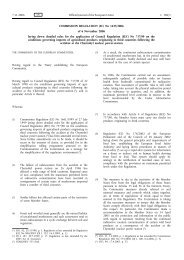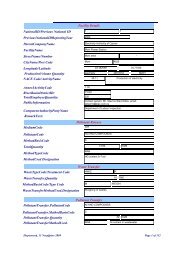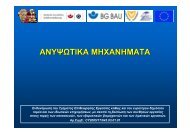Non binding guide to good practice for implementing Directive
Non binding guide to good practice for implementing Directive
Non binding guide to good practice for implementing Directive
- No tags were found...
Create successful ePaper yourself
Turn your PDF publications into a flip-book with our unique Google optimized e-Paper software.
<strong>Non</strong> <strong>binding</strong> <strong>guide</strong> <strong>to</strong> <strong>good</strong> <strong>practice</strong> <strong>for</strong> <strong>implementing</strong> <strong>Directive</strong> 2002/44/EC (Vibrations at Work)3.2 CONSULTATION AND PARTICIPATIONOF WORKERSThe successful management of risks relies on the supportand involvement of workers, and in particular theirrepresentatives. Representatives can provide an effectivechannel of communication with the work<strong>for</strong>ce and assistworkers in understanding and using health and safety in<strong>for</strong>mation.Lower-back pain may be caused by a combination of fac<strong>to</strong>rs,including whole-body vibration exposure, so a varietyof different solutions may be necessary. Some solutionsmay be quite straight<strong>for</strong>ward. Other solutions will requiremodifi cations <strong>to</strong> the way in which work is organised.These issues can often only be effectively dealt with inconsultation with workplace representatives.Effective consultation relies on:• the sharing of relevant in<strong>for</strong>mation about health andsafety measures with workers;• workers being given the opportunity <strong>to</strong> express theirviews and <strong>to</strong> contribute in a timely fashion <strong>to</strong> the resolutionof health and safety issues;• the views of workers being valued and taken in <strong>to</strong>account.3.3.1 Substitution of other working methodsIt may be possible <strong>to</strong> fi nd alternative work methodsthat avoid or reduce exposure <strong>to</strong> vibration, e.g. bytransporting materials by conveyor rather than usingmobile machinery. To keep up-<strong>to</strong>-date on the methodsavailable you should check regularly with:• your trade association;• other industry contacts;• equipment suppliers;• trade journals.3.3.2 Equipment selectionConsultation can result in better control solutions beingidentifi ed that are well unders<strong>to</strong>od by the workers. You willbe relying on workers <strong>to</strong> make the control measures effective.Subject <strong>to</strong> adequate training and supervision, workershave a duty <strong>to</strong> make correct use of machinery and <strong>to</strong>cooperate with the employer <strong>to</strong> enable them <strong>to</strong> ensure thattheir environment and working conditions are safe, suchthat risks <strong>to</strong> safety and health are minimised and wherepossible eliminated. The process of consultation encouragesworker involvement and co-operation with controlmeasures and so ensures that controls are more likely <strong>to</strong>be successfully implemented.3.3 RISK CONTROLSTo control exposure you must avoid or reduceexposure <strong>to</strong> whole-body vibration. It may also bepossible <strong>to</strong> take actions that reduce the likelihoodof developing or aggravating injury. It is likely thateffective control will be based on a combinationof several methods.In this chapter we look at the engineering,management and other methods that should beconsidered when looking <strong>for</strong> control solutions.You should make sure that equipment selected or allocated<strong>for</strong> tasks is suitable and can do the work effi ciently.Equipment which is unsuitable or of insuffi cient capacity islikely <strong>to</strong> take much longer <strong>to</strong> complete the task and exposeworkers <strong>to</strong> more vibration <strong>for</strong> longer than is necessary.Choose machines with cab layouts and control leversarranged so that the opera<strong>to</strong>r is able <strong>to</strong> maintain a com<strong>for</strong>tableupright posture and will not need <strong>to</strong> twist thebody excessively, or maintain twisted postures <strong>for</strong> anylength of time.Selection of tyres can be important; tyres will absorbsome effects of uneven ground. However, tyres cannotabsorb the vibration from larger lumps and potholes, andsoft tyres on undulating ground can amplify a vehicle’svertical motions. Tyres need <strong>to</strong> be selected so that thevehicle can handle rougher terrain.3.3.3 Purchasing policyMake sure your purchasing department has a policy onpurchasing suitable equipment that takes in<strong>to</strong> accounthealth and safety issues, including: vibration emission,ergonomic fac<strong>to</strong>rs, driver vision and your operating requirements.76


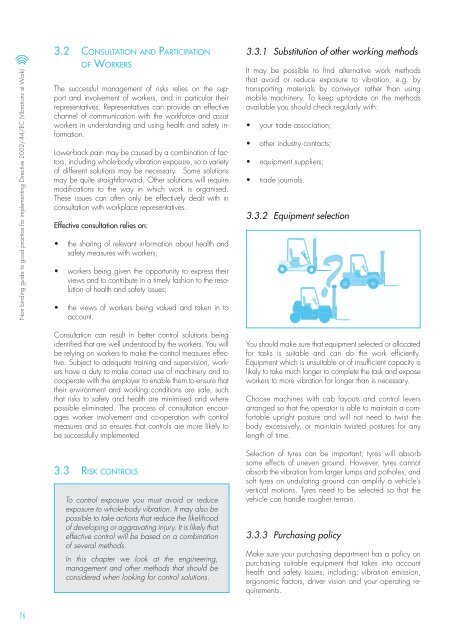




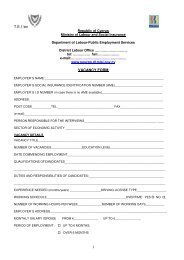
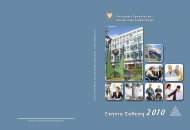
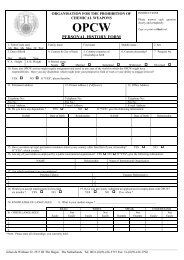
![Hadjimichael[1].pdf](https://img.yumpu.com/33937965/1/190x135/hadjimichael1pdf.jpg?quality=85)

